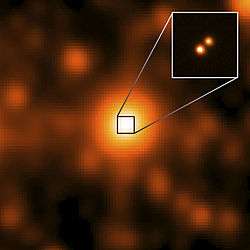Kepler-65
Kepler-65 is a star slightly more massive than the Sun and has at least four planets.
| Observation data Epoch J2000 Equinox J2000 | |
|---|---|
| Constellation | Lyra |
| Right ascension | 19h 14m 45.2920s[1] |
| Declination | +41° 09′ 04.207″[1] |
| Apparent magnitude (V) | 11.018 |
| Characteristics | |
| Astrometry | |
| Proper motion (μ) | RA: 0.970±0.056[1] mas/yr Dec.: −14.189±0.056[1] mas/yr |
| Parallax (π) | 3.2638 ± 0.0289[1] mas |
| Distance | 999 ± 9 ly (306 ± 3 pc) |
| Details | |
| Mass | 1.25 M☉ |
| Radius | 1.41 R☉ |
| Temperature | 6211 K |
| Metallicity [Fe/H] | +0.17 dex |
| Rotation | 7.911±0.155 days[2] |
| Other designations | |
| Database references | |
| SIMBAD | data |
| KIC | data |
Planetary system
Three transiting planets were announced in 2013. A fourth non-transiting planet was discovered using radial velocity measurements in 2019.[4] The first three planets orbit very close to their star. Initial follow-up radial velocity measurements provided data too noisy to constrain the mass of planets.[5] Follow-up transit-timing variation analysis helped to measure the mass of Kepler-65d which revealed that it has significantly lower density than Earth.[6]
| Companion (in order from star) |
Mass | Semimajor axis (AU) |
Orbital period (days) |
Eccentricity | Inclination | Radius |
|---|---|---|---|---|---|---|
| b | 2.4+2.4 −1.6 M⊕ |
0.035 | 2.1549209+0.0000086 −0.0000074 |
0.028+0.031 −0.02 |
92.2+1.3 −1.4° |
1.444+0.037 −0.031 R⊕ |
| c | 5.4±1.7 M⊕ | 0.068 | 5.859697+0.000093 −0.000099 |
0.02+0.022 −0.013 |
92.33+0.29 −0.26° |
2.623+0.066 −0.056 R⊕ |
| d | 4.14+0.79 −0.80 M⊕ |
0.084 | 8.13167+0.00024 −0.00021 |
0.014+0.016 −0.010 |
92.35+0.18 −0.16° |
1.587+0.040 −0.035 R⊕ |
| e | 200+200 −50 M⊕ |
— | 258.8+1.5 −1.3 |
0.283+0.064 −0.071 |
127.0+27.0 −25.0° |
— |
gollark: Due to technical limitations it relies on a server, but you can host your own.
gollark: Over websockets.
gollark: Modemless networking.
gollark: emux.cc or whatever.
gollark: Use CCemux.
External links
References
- Brown, A. G. A.; et al. (Gaia collaboration) (August 2018). "Gaia Data Release 2: Summary of the contents and survey properties". Astronomy & Astrophysics. 616. A1. arXiv:1804.09365. Bibcode:2018A&A...616A...1G. doi:10.1051/0004-6361/201833051. Gaia DR2 record for this source at VizieR.
- McQuillan, A.; Mazeh, T.; Aigrain, S. (2013). "Stellar Rotation Periods of The Kepler objects of Interest: A Dearth of Close-In Planets Around Fast Rotators". The Astrophysical Journal Letters. 775 (1). L11. arXiv:1308.1845. Bibcode:2013ApJ...775L..11M. doi:10.1088/2041-8205/775/1/L11.
- "Kepler-65". SIMBAD. Centre de données astronomiques de Strasbourg. Retrieved 10 January 2017.
- Mills, Sean M.; et al. (2019). "Long-period Giant Companions to Three Compact, Multiplanet Systems". The Astronomical Journal. 157 (4). 145. arXiv:1903.07186. Bibcode:2019AJ....157..145M. doi:10.3847/1538-3881/ab0899.
- Chaplin, W. J.; et al. (2013). "Asteroseismic Determination of Obliquities of the Exoplanet Systems Kepler-50 and Kepler-65". The Astrophysical Journal. 766 (2). 101. arXiv:1302.3728. Bibcode:2013ApJ...766..101C. doi:10.1088/0004-637X/766/2/101.
- Hadden, Sam; Lithwick, Yoram (2014). "Densities and Eccentricities of 139 Kepler Planets from Transit Time Variations". The Astrophysical Journal. 787 (1). 80. arXiv:1310.7942. Bibcode:2014ApJ...787...80H. doi:10.1088/0004-637X/787/1/80.
This article is issued from Wikipedia. The text is licensed under Creative Commons - Attribution - Sharealike. Additional terms may apply for the media files.


